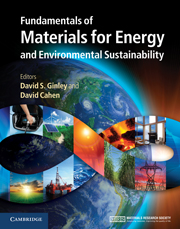Book contents
- Frontmatter
- Contents
- Contributors
- Preface
- Acknowledgments
- Part 1 Energy and the environment: the global landscape
- 1 A primer on climate change
- 2 The global energy landscape and energy security
- 3 Sustainability and energy conversions
- 4 Energy cost of materials: materials for thin-film photovoltaics as an example
- 5 Economics of materials
- 6 Global energy flows
- 7 Global materials flows
- 8 Carbon dioxide capture and sequestration
- Part 2 Nonrenewable energy sources
- Part 3 Renewable energy sources
- Part 4 Transportation
- Part 5 Energy efficiency
- Part 6 Energy storage, high-penetration renewables, and grid stabilization
- Summary
- Appendix A Thermodynamics
- Appendix B Electrochemistry
- Appendix C Units
- Index
- References
5 - Economics of materials
from Part 1 - Energy and the environment: the global landscape
Published online by Cambridge University Press: 05 June 2012
- Frontmatter
- Contents
- Contributors
- Preface
- Acknowledgments
- Part 1 Energy and the environment: the global landscape
- 1 A primer on climate change
- 2 The global energy landscape and energy security
- 3 Sustainability and energy conversions
- 4 Energy cost of materials: materials for thin-film photovoltaics as an example
- 5 Economics of materials
- 6 Global energy flows
- 7 Global materials flows
- 8 Carbon dioxide capture and sequestration
- Part 2 Nonrenewable energy sources
- Part 3 Renewable energy sources
- Part 4 Transportation
- Part 5 Energy efficiency
- Part 6 Energy storage, high-penetration renewables, and grid stabilization
- Summary
- Appendix A Thermodynamics
- Appendix B Electrochemistry
- Appendix C Units
- Index
- References
Summary
Focus
Improvements in materials have played a primary role in the transition from a bare subsistence economy to current high living standards in the developed world. They will be even more important in meeting the challenges of increasing pollution, changing global climate, growing population, and increasing resource demands that humankind will face in the twenty-first century. However, the marvelous structures created by materials science are only scientific curiosities unless they can compete with (and, ultimately, supplant) existing materials and technologies by being cheaper and more useful. This chapter explores the close connection between materials and economics.
Synopsis
The fierce competition among materials for markets drives innovation in materials, cost reductions, and new designs both in terms of materials and in terms of the products and processes that compose US and world economic activity. The invention and discovery of new materials in the laboratory drive innovation, making possible products and processes that were only engineering dreams in the past. New products and designs require new materials, spurring innovation. Indeed, some materials have the potential to lead to more desirable products and services, decreased energy use, reduced risks to the environment and human health, and reduced consumption of scarce resources.
- Type
- Chapter
- Information
- Publisher: Cambridge University PressPrint publication year: 2011



